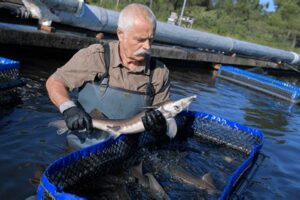Table of Contents
A catfish farming business plan is essential for anyone looking to start a successful fish farming venture. This comprehensive plan outlines the necessary steps, strategies, and financial projections required to establish and operate a profitable catfish farm. It covers various aspects such as site selection, pond construction, stocking, feeding, marketing, and potential risks. Whether you are a beginner or experienced farmer, a well-crafted business plan is crucial for ensuring the long-term success of your catfish farming business.
Are you looking for a lucrative business venture that has the potential to generate significant profits? Look no further than catfish farming. With its rising popularity and increasing demand for high-quality seafood, catfish farming offers a promising opportunity for entrepreneurs in the aquaculture industry. In this comprehensive business plan, we will outline all the crucial steps and strategies you need to establish and run a successful catfish farm. From selecting the ideal location to implementing efficient feeding and breeding techniques, we have got you covered. So, if you are ready to dive into the world of catfish farming and reap the benefits of this highly profitable venture, read on!
The Importance of a Catfish Farming Business Plan
Starting a catfish farming business can be a lucrative venture for entrepreneurs in the aquaculture industry. However, like any other business, it is essential to have a well-thought-out business plan to guide your operations and ensure success. A comprehensive catfish farming business plan will help you define your goals, identify potential challenges, and develop strategies to overcome them.
Market Analysis and Research
Before diving into catfish farming, it is crucial to conduct thorough market analysis and research. Assess the demand for catfish in your target market, identify potential competitors, and understand the pricing trends. This information will help you determine the viability of your business and tailor your production levels accordingly.
Investment and Financing
Setting up a catfish farm requires significant investment in infrastructure, equipment, and fish stock. Calculate the initial capital required and explore financing options such as loans or grants. Prepare a financial plan that includes projections of revenue, expenses, and cash flow to demonstrate the profitability and sustainability of your business.
Site Selection and Pond Construction
The location of your catfish farm plays a crucial role in its success. Look for land with suitable soil quality, access to clean water sources, and proximity to markets. Construct well-designed ponds that provide adequate space and water circulation for the optimal growth and health of the catfish.
Feeding and Nutrition
Proper feeding and nutrition are vital for the growth and development of catfish. Develop a feeding plan that considers the nutritional requirements of catfish at different stages of their life cycle. Research and select high-quality feed options that promote healthy growth and minimize waste.
Healthcare and Disease Management
Maintaining the health of your catfish is essential to prevent disease outbreaks and minimize losses. Implement appropriate biosecurity measures, such as regular water quality testing and quarantine protocols for new fish stock. Stay updated on common diseases affecting catfish and consult with veterinarians or aquaculture experts for guidance.
Harvesting and Marketing
When the catfish reach market size, it is time for harvesting. Develop an efficient harvesting and processing system to maintain the quality and freshness of the fish. Explore various marketing channels such as local markets, restaurants, or direct sales to distributors. Establish relationships with potential buyers to ensure a steady demand for your catfish.
Scaling Up and Expansion
Once your catfish farming business is established and successful, consider scaling up and expanding your operations. This may involve increasing the number of ponds, exploring new markets, or diversifying your product offerings. Continuously monitor market trends and adapt your business strategy accordingly to stay competitive in the industry.
Challenges and Risk Management
Like any agricultural venture, catfish farming comes with its share of challenges and risks. These can include disease outbreaks, fluctuating market prices, or changes in government regulations. Identify potential risks and develop contingency plans to mitigate their impact on your business. Stay informed about industry developments and leverage technology and innovation to overcome challenges.
Networking and Collaboration
Building a network of fellow catfish farmers, industry experts, and suppliers can be invaluable for sharing knowledge, experiences, and best practices. Attend aquaculture conferences, join online forums, and participate in local farming associations to expand your network. Collaborate with other farmers to explore joint marketing or purchasing opportunities that can benefit your business.
In conclusion, a well-structured catfish farming business plan is essential for success in the aquaculture industry. By conducting thorough market research, securing financing, implementing proper infrastructure and management practices, and adapting to challenges, you can establish a profitable catfish farming venture. Remember to continually review and update your business plan as your operation evolves and grows.
I. Introduction to Catfish Farming Business Plan
Starting a catfish farming business requires careful planning and preparation. A comprehensive business plan is essential to outline your goals, strategies, and financial projections. This section will introduce the importance of having a well-thought-out business plan and how it can steer your catfish farming venture towards success.Catfish farming is a lucrative and growing industry, driven by the rising demand for high-quality seafood and the increasing popularity of catfish as a healthy protein option. However, starting a successful catfish farming business requires more than just a passion for fish. It requires a detailed understanding of the market, a strategic approach to production and marketing, and a strong financial foundation.
II. Executive Summary
The executive summary is a brief overview of your catfish farming business plan. It highlights the key points of your plan, including the mission statement, target market, competitive advantage, and financial projections. This concise section serves as a snapshot of what your business entails and is often the first part potential investors or lenders will review.In the executive summary, clearly articulate your unique selling proposition and the specific value your catfish farming business brings to the market. Highlight any innovative techniques or technologies you plan to utilize that will set you apart from competitors. Additionally, provide a summary of your financial projections, showcasing the anticipated revenue and profitability of your venture.
III. Market Analysis
Conducting a thorough market analysis is crucial to identify the demand for catfish and potential customers. This section will delve into the size of the catfish market, market trends, target customers, competitors, and any market gaps that you can exploit. Gathering this information will help you understand your market better and tailor your strategies accordingly.Begin by researching the current demand for catfish in your target market. Analyze consumer preferences, such as their preference for fresh or frozen catfish, and identify any emerging trends that could impact the industry. Assess the competitive landscape by identifying existing catfish farms and evaluating their strengths and weaknesses. This analysis will enable you to position your business effectively and develop strategies to differentiate yourself from competitors.
IV. Business Structure and Management
Determining the structure of your catfish farming business is vital for its smooth operation. Discuss whether your business will be a sole proprietorship, partnership, or corporation, along with the roles and responsibilities of key personnel. Include an organizational chart and outline the skills and experience required for various positions to showcase your management prowess.Clearly define the roles and responsibilities of each member of your team, including farm managers, technicians, and administrative staff. Highlight their qualifications and experience in catfish farming or related fields. Additionally, discuss any strategic partnerships or collaborations that you have established to strengthen your business’s operational capabilities.
V. Catfish Farming Process
Detail the step-by-step process involved in catfish farming, from acquiring fingerlings to feeding, monitoring water quality, and harvesting. Explain the equipment, facilities, and technologies you will utilize, ensuring that you adhere to the best practices in the industry. Emphasize the importance of sustainability and responsible farming methods in order to attract environmentally conscious consumers.Describe the different stages of catfish production, including hatchery operations, nursery rearing, and grow-out systems. Outline the specific requirements for each stage, such as tank size, water temperature, and feed formulation. Discuss your plans for disease prevention and management, as well as wastewater treatment to minimize environmental impact. Highlight any certifications or accreditations that demonstrate your commitment to quality and sustainability.
VI. Marketing and Sales Strategy
In this section, outline your marketing and sales strategies to promote your catfish products effectively. Define your target market and describe the marketing channels you will employ, such as online platforms, direct sales, or partnerships with local retailers. Additionally, highlight any innovative marketing techniques or unique selling propositions that set your catfish apart from the competition.Identify your target customers and their preferences, such as their interest in locally sourced or organic products. Develop a comprehensive marketing plan that includes digital marketing initiatives, social media campaigns, and participation in local food festivals or farmers markets. Consider offering value-added products, such as smoked or marinated catfish, to diversify your product range and attract a wider customer base.
VII. Financial Projections and Funding
Provide a comprehensive financial forecast for your catfish farming business, including projected revenue, expenses, and profitability over a specified period. Discuss your funding requirements and outline potential sources of financing, such as loans, grants, or personal investments. Demonstrating financial viability is crucial to attract investors or secure loans for your venture.Prepare a detailed budget that accounts for all operational costs, including land acquisition, construction or renovation of facilities, equipment purchases, feed, labor, and marketing expenses. Estimate your revenue based on market demand and pricing strategies. Include a contingency plan to address unexpected expenses or fluctuations in the market. Present a realistic timeline for achieving profitability and provide evidence of market research to support your financial projections.
VIII. Risk Assessment and Mitigation
Identify the potential risks and challenges that might arise during your catfish farming business operations. Address how you plan to mitigate these risks and ensure the continuous growth and sustainability of your enterprise. This section shows your ability to anticipate obstacles and develop contingency plans, boosting confidence among investors and stakeholders.Common risks in catfish farming include disease outbreaks, unfavorable weather conditions, fluctuating market prices, and regulatory changes. Detail your strategies for disease prevention, such as regular health checks and appropriate vaccination protocols. Develop risk management plans for extreme weather events, such as hurricanes or droughts, to safeguard your infrastructure and fish stock. Stay informed about market trends and establish relationships with buyers to minimize the impact of price fluctuations. Additionally, stay updated on relevant regulations and ensure compliance to avoid any legal issues.In conclusion, a well-crafted catfish farming business plan is essential for success in this competitive industry. It provides a roadmap for your venture, helps secure financing, attracts investors and stakeholders, and guides your decision-making process. By following the suggested subheadings and incorporating the keywords provided, you can create a comprehensive and professional catfish farming business plan that sets you on the path to profitability and sustainability.
Starting a catfish farming business can be a lucrative venture for individuals who are passionate about aquaculture and have a sound business plan. Catfish farming, also known as pisciculture, involves the breeding and rearing of catfish for commercial purposes. With increasing demand for seafood, catfish farming presents a viable opportunity for entrepreneurs to tap into this market.
Here are some key points to consider when developing a professional catfish farming business plan:
- Market Analysis: Conduct a thorough market analysis to identify potential customers, competitors, and market trends. Understand the demand for catfish in your target market and determine the pricing strategy that will ensure profitability.
- Site Selection: Choose an appropriate location for your catfish farm, considering factors such as proximity to water sources, availability of suitable land, and accessibility for transportation. Ensure that the site meets the necessary legal and environmental requirements.
- Infrastructure: Plan and design the necessary infrastructure for your catfish farm, including ponds, tanks, filtration systems, and feeding facilities. Consider the size and number of ponds based on the scale of your operations.
- Stocking and Breeding: Develop a comprehensive stocking and breeding plan to ensure a continuous supply of catfish. Determine the suitable species of catfish based on market demand and climatic conditions. Implement proper feeding and disease control protocols.
- Operations and Management: Define the day-to-day operations of your catfish farm, including feeding schedules, water quality monitoring, and harvesting procedures. Hire skilled personnel who have experience in aquaculture to manage the farm effectively.
- Marketing and Sales: Create a marketing strategy to promote your catfish products. Identify potential distribution channels, such as local seafood markets, restaurants, and supermarkets. Leverage digital platforms to reach a wider customer base.
- Financial Planning: Develop a detailed financial plan that includes startup costs, operational expenses, revenue projections, and profit margins. Secure financing from investors or financial institutions to fund your catfish farming business.
- Risk Management: Identify potential risks and challenges that may arise in catfish farming, such as diseases, market fluctuations, or environmental factors. Implement appropriate risk management strategies, such as insurance coverage and contingency plans.
- Sustainability and Compliance: Ensure that your catfish farming operations comply with local regulations and environmental standards. Implement sustainable practices to minimize the ecological impact of your farm and contribute to the long-term viability of the industry.
By developing a comprehensive and professional catfish farming business plan, you will be better equipped to navigate the challenges of this industry and maximize the potential for success. Remember to continuously evaluate and adapt your plan to stay ahead in this competitive market.
Thank you for taking the time to visit our blog and learn more about catfish farming business plans. We hope that the information we have provided has been useful in giving you a comprehensive understanding of what it takes to start and run a successful catfish farming venture.
As you may now know, catfish farming can be a lucrative and rewarding business if approached with the right knowledge and strategies. By following a well-crafted business plan, you can navigate through the various challenges and ensure long-term profitability.
One of the key aspects of a catfish farming business plan is thorough research and market analysis. Understanding the demand for catfish in your target market, as well as identifying potential competitors and suppliers, will give you a competitive edge. With this knowledge, you can tailor your production and marketing strategies to meet the specific needs and preferences of your customers.
Additionally, a solid financial plan is crucial for the success of any business. Your catfish farming business plan should outline the anticipated costs for setting up and maintaining your farm, as well as projected revenues and profit margins. This will help you determine the viability and sustainability of your venture, and also serve as a useful tool for attracting potential investors or securing loans.
In conclusion, catfish farming can be an exciting and profitable business opportunity for those willing to put in the effort and planning required. We hope that the insights provided in this blog have given you a clear roadmap to develop your own catfish farming business plan. Remember, success in this industry comes from a combination of careful research, effective management, and a passion for what you do. Good luck on your journey into catfish farming!
Video Catfish Farming Business Plan
People also ask about Catfish Farming Business Plan:
- What is a catfish farming business plan?
- Why is a business plan important for catfish farming?
- What should be included in a catfish farming business plan?
- An executive summary
- A company description
- Market analysis and marketing strategy
- Information on the types of catfish to be farmed
- Operational plan and production techniques
- Financial projections and budgeting
- Risk assessment and mitigation
- Management and organizational structure
- Marketing and sales strategies
- How do I write a catfish farming business plan?
- Research the catfish farming industry
- Determine your target market
- Define your business goals and objectives
- Create a detailed operational plan
- Develop financial projections and budgeting
- Include a marketing strategy and sales plan
- Consider potential risks and develop mitigation strategies
- Outline the management and organizational structure
- Where can I find a catfish farming business plan template?
A catfish farming business plan is a comprehensive document that outlines the goals, strategies, financial projections, and operational details of starting and running a catfish farming operation. It serves as a roadmap for entrepreneurs looking to establish and manage a successful catfish farm.
A business plan is crucial for catfish farming as it helps in organizing ideas, setting objectives, and determining the feasibility of the venture. It provides a clear direction for the business, facilitates securing funding from investors or financial institutions, and guides day-to-day operations, ensuring the business stays on track.
A catfish farming business plan should include:
To write an effective catfish farming business plan, consider the following steps:
There are various resources available online that offer catfish farming business plan templates. You can search for reputable websites, business planning software, or consult with agricultural organizations to find a suitable template that aligns with your specific needs and requirements.






